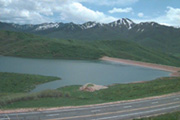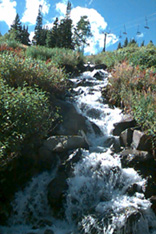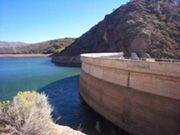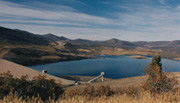Bulletin Board
Wasatch Front Dry Spell?
May 16, 2000
|
|
Ivan. W. Flint, Weber Basin Water Conservancy District General Manager, said that last year at this time they were concerned with too much run-off. “We were releasing water from reservoirs to make room for the expected high run off,” exclaimed Flint, “you never know what to expect from year to year.” Willard Bay will fill this year, but East Canyon, Lost Creek and Pineview reservoirs won’t fill. “Six weeks ago, projections look good with forecasts of 95 percent normal run off, but it hasn’t materialized,” says Flint, “The streams are not even muddy this year.” Flint did not contemplate any restrictions during the coming year. “We’ll conserve what we can, but we don’t figure on any reduction in
|
|
LeRoy W. Hooton, Jr., Salt Lake City Department of Public Utilities Director, said that Salt Lake City serves retail water to over 90,000 connections within Salt Lake City and eastern Salt Lake County. Sixty percent of Salt Lake City’s water supply comes from the Wasatch Canyon streams and the projected run-off varies between a low of 30 percent in Parleys to a high of 70 percent in Little Cottonwood Creek. Little Dell is now projected to fill to 80 percent capacity with 14,500 acre-feet. About 15 percent of the water supply comes from deep wells, and the ground water aquifer appears to be in good shape. The remaining 25 percent of the City’s water supply comes from the Metropolitan Water District of Salt Lake City. Hooton noted, “We are definitely in a drier regime and we may be challenged this summer if it’s hot and dry.”
Nick P. Sefakis, Metropolitan Water District of Salt Lake City General Manager, told the group that his district is the oldest special district in the state. It was formed
by Salt Lake City in 1935 to participate in the Provo River Project. In 1990, Sandy City was annexed into the district. The district owns the Little Cottonwood Water
Treatment Plant at the mouth of Little Cottonwood Canyon and has 2/7th capacity in the Jordan Valley Water Treatment Plant. The district’s water supplies come from
Little Dell, Deer Creek and Jordanelle reservoirs. “Deer Creek is now at 123,000 acre-feet of storage and there is a good chance that it will not fill this year,” said
Sefakis, “meaning that there will be no extra allotment or carry-over water this year.”
Mr. Sefakis agreed that this would be a different year, with less water than normal.

Tage Flint, Jordan Valley Water Conservancy District Treatment and Water Supply Manager told the group that his district serves water to the areas not served by Salt Lake City. He said the district is within the fastest growing part of the county and the state of Utah. Their water deliveries have doubled in the past 15 years and are expected to double again in the next 20 years. The district’s current water supplies are projected to run out by 2006 –2008. The district has deep wells, Provo River Project water and is the largest petitioner for Central Utah Project water with 50,000 acre-feet. They plan to develop additional ground water supplies, convert irrigation water to municipal water supply and acquire water from Bear River. As to this year, Flint said, “We are fine this year. We will have to rely more on stored water and ground water resources to make up for lower direct stream flows on the Provo River.” If there is a second year of less than normal snowpack, there could be concern next year.
Gene Shawcroft, Central Utah Water Conservancy District Assistant General Manager, noted that Jordanelle Reservoir will most likely not fill this year. The 314,000 acre-foot reservoir is designed to cover water short years and fill during wet years. Currently there is 35,000 acre-feet to fill. Shawcroft said, “The district does not anticipate any problem in meeting Central Utah Project demands this year.” He,
|
|
Paul Gillette, State Division of Water Resources, said that the state has been studying water usage. They are participating in water measures of secondary water systems within the Weber Basin Water Conservancy District. They have found that in some cases excessive water consumption occurs on unmetered secondary water systems. The metering will help develop data on usage from these systems. He noted that their studies indicate that as far as in-house water consumption goes, Utahans don’t use any more water than anyone else. However, there is excessive water used for outside watering. “Automatic sprinkling systems with timers use the most,” exclaimed Gillette, “but without the timers, less water is used.”
Tage Flint said that Jordan Valley Water Conservancy Distinct is implementing a progressive water conservation program with a goal of reducing outside watering by 20 percent. The district projects a savings of 15,000 acre-feet of water by 2020 by using more efficient watering techniques. He felt that this could be accomplished without dramatically altering landscape customs.
Hooton showed a chart indicating that Salt Lake City’s water peaking rates have been successful in conserving water. During this past decade, despite over 13 percent growth in connections, Salt Lake City’s total water delivered has remained flat and peak demand has slightly declined. Salt Lake City’s conservation goal is to reduce outside watering by 25 percent with a savings of 13,000 acre-feet by 2025.
Sefakis noted that conservation will play a larger role in the future and that outside landscaping will have to be changed more towards xeriscape practices.


